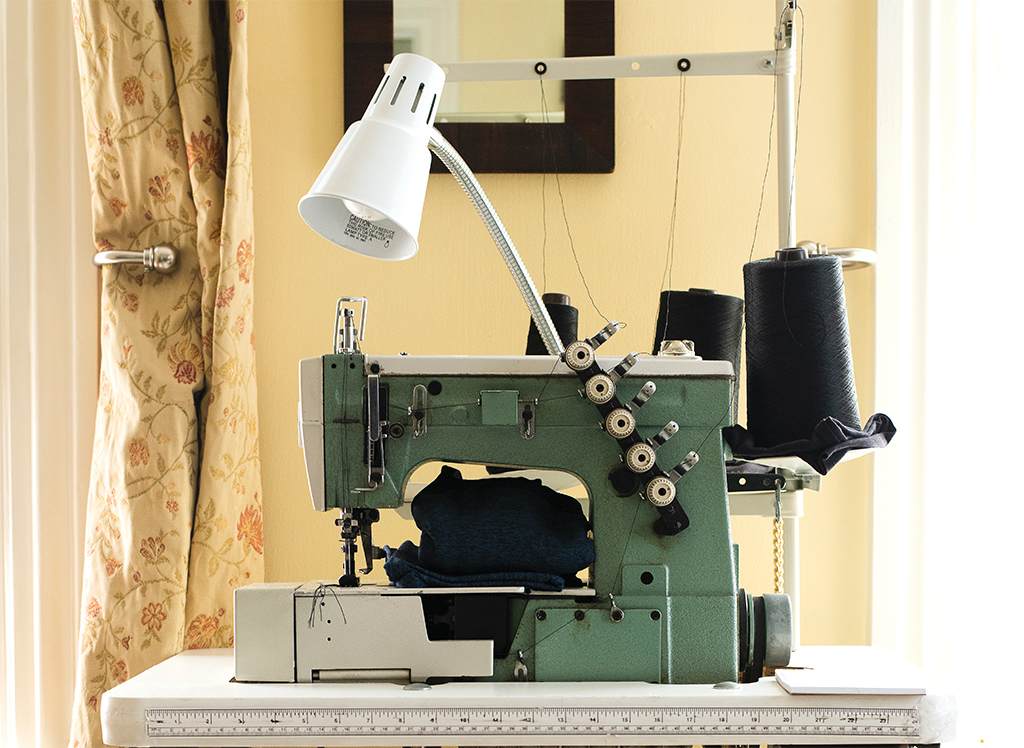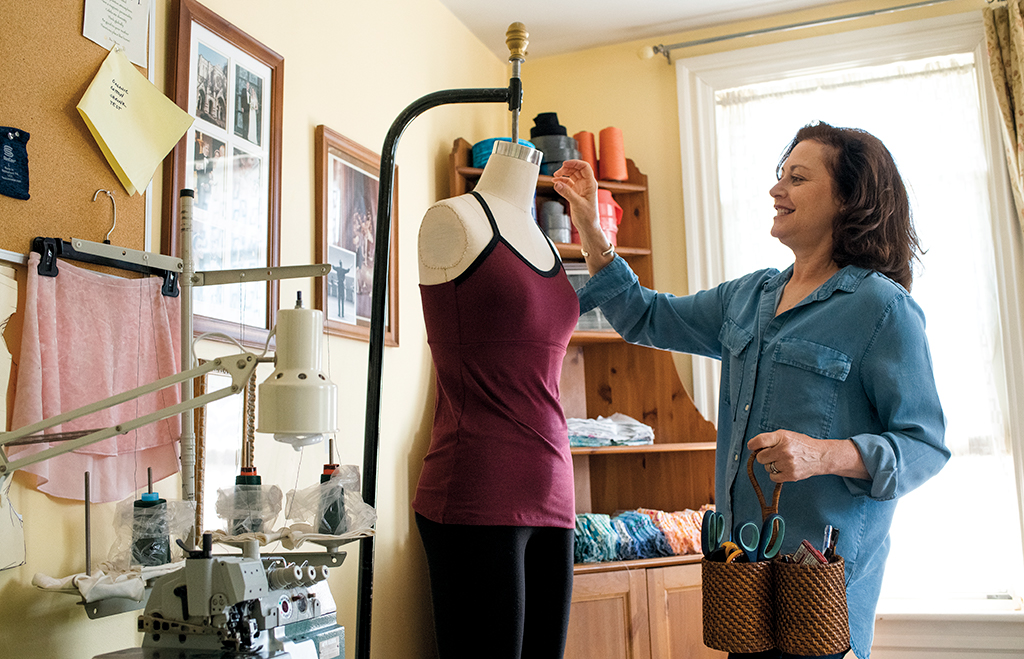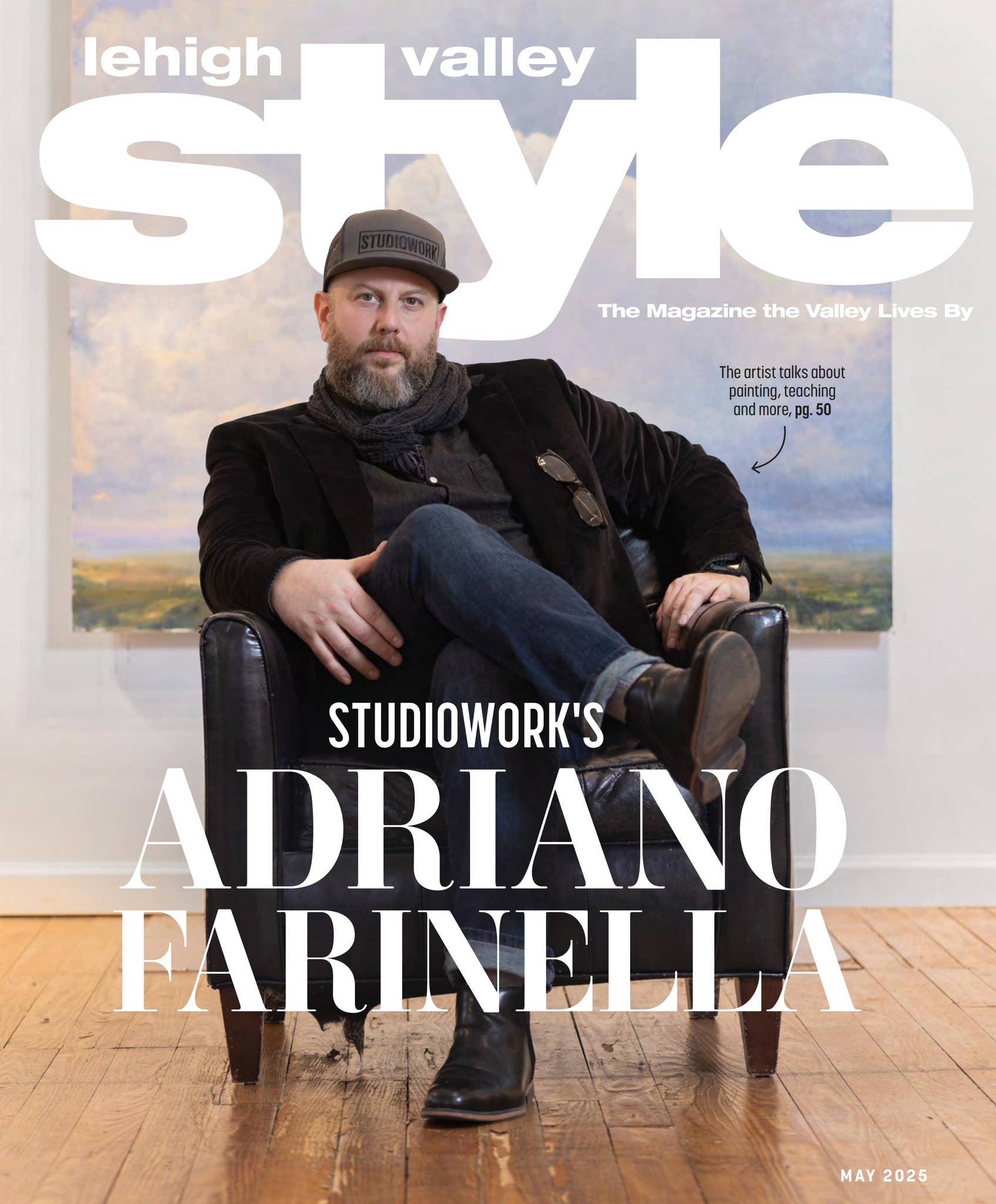Marisa Cerveris has perfected the pivot, and not just in the sense of executing an impeccable turn on the stage or in the studio. The former dancer with the famed New York City Ballet has embraced several new beginnings in her professional life, most recently when a global pandemic necessitated the need to switch gears at her Bethlehem-based design house and dance studio.
Cerveris made her first major pivot in 2001. The then California resident was wrapping up her professional dancing career and heading east in August of that year with her husband, John Savage, and newborn son, Julian.
Savage had been offered a teaching position at Lehigh University. “We thought we'd be going into the city all of the time,” says Cerveris. By “the city,” Cerveris is referring to New York City (sorry, Philly fans), where she and Savage lived for many years. But then, following the horrors of the 9/11 terror attacks, Cerveris and her family were compelled to stay closer to their new home. “We really didn't know Bethlehem or Allentown at all when we first moved here,” she says.
What Cerveris did know by that time was dancewear. After all, she spent 30-some years as a dancer, including 10 with the New York City Ballet. She began sewing some of her own pieces in the late 1980s and early '90s. “It was really very mercenary,” she explains. “Whatever I needed. If I couldn't find it, I started making it.” And, as a young woman juggling a schedule jam-packed with rehearsals and performances, she didn't have the luxury of letting Google or Amazon do the one-click ordering for her. “I'd get frustrated because there wasn't time to shop. There wasn't online shopping then,” says Cerveris. And forget about wasting your time in the return/exchange department. “If you bought something and the strap broke, it was a disaster.”
She was a quick study, and it helped that she was working near New York City's Garment District, where many a budding fashionista has sought out inspiration. Cerveris recalls popping on a pair of sunglasses and walking there to check out the goods in between shows. It also helped that she had friends “in the biz”; her first mannequin (which she still has) had been used to make leotards for the company of Broadway's mainstay show Cats.

When her career took her overseas, she brought her sewing machine with her, with the appropriate electrical adapters in tow. By that time, she says, her apparel was getting noticed by others, and she was getting requests from friends. “I started thinking, ‘I really like doing this,'” Cerveris says. “You start thinking of a transition, what you're going to do next.”
Following her move to Bethlehem, Cerveris made her pivot to fashion designer complete with the cultivation of ByMarisa, her namesake line of handmade, couture-quality dancewear, featuring elastic-free bodywear, which Cerveris says was a first for the market. It didn't take long for her designs to catch the eye of some high-profile clients; Cerveris recalls the day she got a phone call from the costume designer on Robert Altman's 2003 film The Company, starring Neve Campbell as an aspiring ballerina in Chicago. “They were looking for dancers to look the way they look in the studio,” Cerveris explains. “They cover and camouflage the bad parts and accentuate the good parts. Dancers know how to do that better than anybody.”
Cerveris found her handiwork in the national spotlight once again in 2012, when she was contacted by ABC's celebrity dance-off, Dancing with Stars. She says she helped to outfit contestants such as actress Pamela Anderson and figure skater Evan Lysacek. One of the costume designer's requests was for separates—tops and bottoms that can make a much-needed bathroom break on the fly a lot less cumbersome than trying to squeeze in and out of a leotard while the clock is ticking. Around the same time, many of Cerveris's dancer friends were starting to transition out of their professional careers and were looking for apparel they could wear outside of the studio. That got Cerveris thinking about new possibilities for her business. “I wanted something that was a broader umbrella,” she says. “That's when I started to think about rebranding.”
A flash of inspiration struck while Cerveris and her husband were attending a concert at SteelStacks in Bethlehem. Cerveris recalls taking in the enormity of the now silent but still imposing blast furnaces that line the outer edge of the campus. She felt a rush of affection for her adopted hometown. “We really embraced Bethlehem. This was our home now,” says Cerveris. In 2012 she officially launched SteelCore, a name meant to reflect strength that comes from within (which also happens to be the company's trademark).

Cerveris is the company's sole designer, and she says every aspect of the design and manufacturing process happens locally, something she's proud of. “I really do try to keep it as close to home as I can,” she says. Cerveris has branched out beyond dancewear to “studio to street wear,” as she calls it, including dresses and accessories. But devotees of her elastic-free leggings (sans center front seam) need not fear; they're still a big part of the lineup. “Our products are really about being comfortable,” Cerveris says. And she has no problem adapting SteelCore's signature pieces to fill whatever she sees as a need in the market, such as a line made from organic and sustainable materials. “I am a small company, but I can be light on my feet,” she says.
And that brings us to another pivot—two, actually. 2015 brought the opening of SteelCore Studio, which offers a variety of ballet, dance and Pilates classes for all ages and abilities. The excitement in Cerveris's voice is palpable when she talks about the studio's white-pine floor, which replicates the floor used by the New York City Ballet. Its unique basketweave design allows dancers to jump and land more softly. Finding the materials and executing the construction was quite an undertaking, but Cerveris says there was no other option: “I was adamant that I wanted to teach on a floor like that. I just wanted it to be like home.”
Then along came the pandemic. Suddenly in-person classes were a no-go. But the switch to virtual instruction wasn't such a stretch for Cerveris. She says she's been trying to get the ball rolling on that trend for 20 years. “When I came here, I didn't have my posse. I didn't have my class,” she explains. But virtual connections can erase geographical constraints that separate friends and colleagues who live on different coasts and in different time zones.
Even before virtual-only classes became a state mandate, Cerveris had a client—a nurse anesthesiologist—who warned her of what might be coming. “She would come to Pilates in a mask, and at first I humored her.”
But soon it became clear that the COVID-19 outbreak was an all-hands-on-deck situation for anyone and everyone who had something to contribute. Cerveris put the brakes on clothing production and switched to mask-making mode in April. In just one month, her company was able to churn out more than 1,000 face masks, many of which she gave to local hospitals, churches and retirement centers.
As the state's shutdown stretches from weeks into months, Cerveris, like so many others, is itching to get back to normal. She misses designing full-time and mourns an annual summer trip to Paris that has been canceled by the coronavirus. She wonders what future Pilates and dance classes will look like in her studio. But she's ready to adapt—to pivot once more, perhaps. And she relishes the good she's been able to do in the community that is now her own. “It's been so rewarding, hearing people's stories,” says Cerveris.
SteelCore Studio | 2502 Schoenersville Rd., Bethlehem | 610.554.4855 | steelcorewear.com















